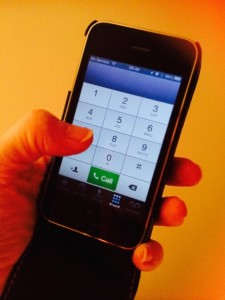A number of car manufacturers are working on technology they hope will reduce distraction while driving. However, these efforts work within a model that essentially says, “If you can’t beat ’em, join ’em.” 
Automakers don’t believe they’ll be able to quell drivers’ desire to stay in touch at all times. So they are working on ways to make doing so safer. But some traffic safety advocates wonder if these well-meaning efforts will backfire by making it easier for drivers to be distracted.
A recent article in The New York Times weighs both sides of the debate.
It opens by describing an ad that’s been posted on YouTube by start-up company Navdy, which project data and driving information onto a screen within a motorist’s field of view.
The video shows a man driving around L.A. when his phone rings. A screen is mounted on the dashboard, and an image of the man’s mother appears – as if floating just above the front edge of the car. They exchange “I Love You’s.”
This kind of technology is one of many that’s hitting the market in coming months.
Some auto manufacturers are working on “smart vehicles” that allow drivers to answer or drop a call, respond to a text message or even listen to one read aloud by simply waving their hands or using voice commands.
Other features include navigation maps, speed alerts, caller identification and even social media notifications. Some larger companies like Google (Android Auto)_ and Apple (CarPlay) have jumped into the game by allowing smartphones to be plugged into the vehicle’s USB port to stream phone data onto a dashboard monitor. Industry analysts say these features are soon going to come standard even in low-end models.
The technology is mostly brand new, and hasn’t been widely used or tested. In fact, Navdy’s product won’t even be for sale until late this year.
Still, these companies drive home the point that this technology is “safe.” It doesn’t require users to take their hands off the wheel or their eyes from the road. But is that really true?
Those developing the technology reason drivers are going to try to multitask anyway, no matter what kinds of features try to discourage them. So why not make it as safe as possible?
But safety advocates say these features wrongly trick a driver into believing these activities are “safe” to do while driving, when in fact the opposite is true. Anytime your attention is divided – regardless of whether you are looking in the direction of the road or are actually using your fingers to text – there is a heightened risk of a crash.
One of those weighing in is a University of Kansas psychologist who studies distraction behind the wheel. He called these so-called “infotainment” systems a “horrible idea.” He said the idea behind it is based on the erroneous presumption that if your head is turned toward the road, you’re somehow safer.
Some companies tout these features – particularly the hologram floating images – as the same used by airplane pilots. However, that is not exactly true. The features pilots use are only critical to the process of flying; i.e., the horizon line. Pilots aren’t updating their Facebook status mid-flight.
Drivers shouldn’t be doing so either – even if it’s floating in front of their faces.
Call Associates and Bruce L. Scheiner, Attorneys for the Injured, at 1-800-646-1210.
Additional Resources:
Windshield Devices Bring Distracted Driving Debate to Eye Level, May 29, 2015, By Matt Richtel, The New York Times
More Blog Entries:
Insurers Sued by Auto Repair Shops Alleging Practices Put Motorists at Risk, May 16, 2015, Fort Myers Auto Injury Lawyer Blog
 Florida Injury Lawyer Blog
Florida Injury Lawyer Blog





